
In Missouri meth labs, Pine studies what he calls a modern-day alchemy. (Photo courtesy Jason Pine, AB’90)
In Missouri and southern Italy, Jason Pine, AB’90, delves into lives on the margin of criminality.
Anthropologist Jason Pine, AB’90, studies how people “make do” in shadowy worlds on the border of licit and illicit. Making do, for Pine, is an art of performance whereby people in complex, precarious environments use “creative pragmatics” to try to take control of their own fates—not just to get by, but to achieve “self-determination and a life that escapes precarity altogether,” he writes.
In Jefferson County, Missouri, south of St. Louis, where home meth labs proliferate, Pine got to know a bartender who provided a view into the drug manufacturing trade. In Italy he became a participant-observer in the Naples underground neomelodica pop music scene. For many struggling Neapolitans, the genre represents one of the most promising avenues to success. But it can be hard to get ahead in neomelodica without brushing up against the camorra, the ubiquitous local crime syndicate, which bootlegs the music and pays singers under the table to perform at clan weddings and baptisms.
Pine’s first research trip to Naples, in 1998, was to study the gesticulatory vocabulary of Neapolitan, the language of southern Italy. He quickly found he needed lessons in swear words so he could speak convincingly, with all the emotional expressiveness of a native speaker.
Pine’s research there, which he pursued through 2004, served as the basis for his doctoral dissertation in anthropology at the University of Texas at Austin, and later his book The Art of Making Do in Naples (University of Minnesota Press, 2012), a first-person ethnography. The book chronicles overlapping and intersecting economies in Naples—formal, informal, and illicit—whose boundaries Pine found hard to make out, if they existed at all. It also tells Pine’s own story of making connections that have lasted far beyond his research. He has kept in touch with several of the subjects, including a neomelodica singer named Fulvio who left southern Italy to become a jazz singer. Fulvio was 12 when Pine first met him, and he later sought out Pine for help with his r’s as he learned to croon American standards.
Pine’s video camera provided his entrée into the world of the young singers, who hired him to make music videos of their work. Though he disclosed that he was in Italy to conduct his doctoral research, suspicions about his true intentions never vanished. Even confidants wondered if he was an informant or an undercover police officer. Pine says there were times when he was harassed or threatened with bodily harm.
More commonly, the Neapolitans would dissemble with him: they “wanted to evade my probing. That was a continual game, they fed me bullshit and I told them it was bullshit.” Going into business with the singers turned into Pine’s own art of making do and his own performance. “The way to get into the scene and work alongside them,” he says, was to “play the same game, sell my wares, negotiate like they were, embellish my talents.”
“I tried to take as few notes as possible,” says Pine, who grew up in New York City and suburban New Jersey; he now lives with his partner in Astoria, Queens, and teaches at SUNY–Purchase College. “I would train my memory to hold onto the details. … In a private moment I would jot down a few things. And the video was a huge help.”
Pine’s current research, on Missouri meth labs, looks at the material culture of what he calls a modern-day alchemy—as distinct from chemistry. The two used to overlap until chemistry “renounced the mysticism,” he says. “But alchemists were experimenters.” He’s interested in how everyday objects used in the manufacture of meth become transformed into high-value objects with a profound affective hold on the people who use them.
The drug’s makers, Pine says, “take everyday consumer goods that can be found at Walmart and transmute them into precious forms of panacea,” much as alchemists used to seek a way to turn lead into gold. “The materials themselves,” Pine says, “are an important part of the narrative. Meth manufacturing is not simply about falling into a dangerous habit,” but about finding raw materials in objects intended for other uses: the lithium strips from Eveready batteries, acid from Drano, ingredients in cold medicine, and ridged Gatorade bottles that expand with pressure.
Uniting all of Pine’s work, says Steven Caton, PhD’84, professor of contemporary Arab studes in Harvard’s anthropology department, is “attention to the surfaces” in everyday life “and how those surfaces have forms, and people become emotionally invested in those surfaces and those forms, regardless of what they might mean or what is behind them.” Caton, who visited Pine in Naples, says the latter’s latest work pushes that perspective “into the world of material and materiality … the stuff, the matter that takes over” the lives of meth makers and users.
Pine frequently returns to Europe to speak at scholarly symposia and keep up with colleagues at the University of Naples who also study organized crime. In the summer of 2013, he presented at the Venice Biennale on the topic of high trash, critiquing former Italian prime minister Silvio Berlusconi and his scandal-ridden tenure.
In December Pine traveled to Naples to finalize a deal with an Italian publisher to translate Making Do. “I want my work to be accessible,” he says. “It’s important to share what I learned with the people I learned it from.”
